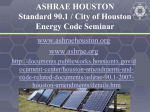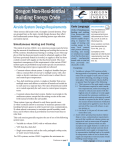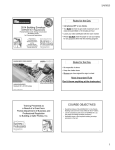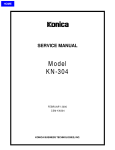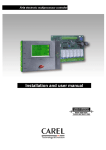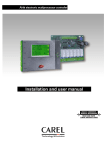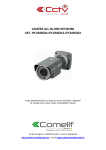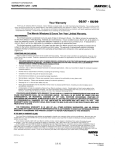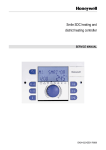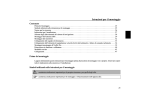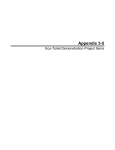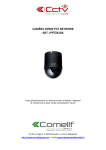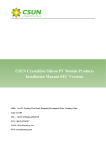Download 2010 Indiana Energy Conservation Code
Transcript
The 2010 Indiana Energy Conservation Code and The 2011 IES Illuminance Recommendations November 29, 2011 presented by Samuel L. Hurt, P.E., R.A., R.I.D. LC, LEED® AP, HFDP sponsored by the American Institute of Architects, Indiana Chapter American Institute of Architects, Indianapolis Chapter 2010 Indiana Energy Conservation Code • Does this look familiar? It should because it was the Indiana Energy Code (with a few amendments) until May 6, 2010. Much changed with the adoption of ASHRAE 90.1-2007 (with Indiana amendments) as the Indiana Energy Conservation Code, 2010 Edition. The 31 addenda that ASHRAE has published for 90.1 over the years have NOT been adopted and are not in force in Indiana. But before this, on 06.28.2008, Governor Daniels signed executive order 08-14 that requires all new State buildings to strive for the goal of improved energy efficiency, as demonstrated by LEED® Silver Certification, Energy Star Certification, or 2 Globes Certification under the Green Globes system (or the equivalent under another ANSI accredited system). Renovations are intended to follow similar guidelines. 2010 Indiana Energy Conservation Code Why me? Not because I’m an Authority Having Jurisdiction or a Code Consultant; I’m neither. But I am versatile and experienced-- B.S.A.D. from M.I.T., Cambridge, Massachusetts 1984 M.Arch. from the University of Oregon, Eugene, Oregon 1985 Registered Architect, Indiana 2001 Professional Engineer, Indiana (and later in Illinois, Michigan and North Carolina) 2002 Lighting Certified by the National Council on Qualifications in the Lighting Professions 2006 LEED® AP by the United States Green Building Council 2008 HFDP (Healthcare Facility Design Professional by ASHRAE) 2009 Registered Interior Designer, Indiana 1981 Vice President/General Manager, JOHN OBERLIES CONSULTING ENGINEERS, INC., 10.1998 Part-time Instructor in Interior Design, The Art Institute of IndianapolisSM, 01.2008 Principal, SHurt lighting design, 03.2009 Author, Codes, Regulations, and Standards in Interior Design, Prentice Hall, 2011 2010 Indiana Energy Conservation Code To explain this new regulation and its use for real projects, each of the following topics will be covered— • • • • • Applicability: to which projects will this apply? General Administrative Rules provisions History: History how did we get here? And why did this change? Enforcement: Enforcement what did we have before and what will we have now? Specific Requirements— Requirements Indiana Amendments Building Envelope HVAC Water Heating Power Lighting Other Equipment • • Compliance Reporting Summary 2010 Indiana Energy Conservation Code To explain this new regulation and its use for real projects, each of the following topics will be covered— • • • • • Applicability: to which projects will this apply? General Administrative Rules provisions History: History how did we get here? And why did this change? Enforcement: Enforcement what did we have before and what will we have now? Specific Requirements— Requirements Indiana Amendments Climate Zones Building Envelope HVAC Water Heating Power Lighting Other Equipment • • Compliance Reporting Summary 2010 Indiana Energy Conservation Code One- and Two-Family Dwellings (Class 2 structures) Covered by the 2005 Indiana Residential Code (based on the 2003 International Residential Code), so no change at all here. (New Chapter 11 -- energy– amendments pending.) Townhouses not more than 3 stories high are classified as Class 1 structures. All Class 1 structures (non-farm) 2008 Indiana Building Code (based on the 2006 International Building Code); 2010 Indiana Energy Conversation Code (based on ASHRAE 90.1-2007); 2008 Indiana Fire Code; 2009 Indiana Electrical Code; 2008 Indiana Mechanical Code; 2008 Indiana Fuel Gas Code, and 1999 Indiana Plumbing Code (But townhouses not more than 3 stories high are subject to the 2005 IRC, even though they are Class 1 structures.) 2010 Indiana Energy Conservation Code To explain this new regulation and its use for real projects, each of the following topics will be covered— • • • • • Applicability: to which projects will this apply? General Administrative Rules provisions History: History how did we get here? And why did this change? Enforcement: Enforcement what did we have before and what will we have now? Specific Requirements— Requirements Climate Zones Indiana Amendments Building Envelope HVAC Water Heating Power Lighting Other Equipment • • Compliance Reporting Summary 2010 Indiana Energy Conservation Code GAR 12-4-12 Existing buildings; additions and alterations “(b) Additions or alterations may be made… without requiring the entire existing building… to comply with all requirements…” “(j) Alterations of buildings built prior to January 21, 1978 (the effective date of the first state rule for energy conservation) need not conform with the new construction requirements of 675 IAC 19.” ASHRAE 90.1-2007 (with amendment language) “4.1.1.3 Alterations of Existing Buildings. Alterations of existing buildings shall comply with the standard as described in Section 4.2 if a construction design release is required for the alterations.” alterations As of 08.26.2010, it has been confirmed that these provisions will be applied to new construction, additions, and alterations, although a gray area remains for buildings built prior to 01.21.1978. Much confusion remains, though. 2010 Indiana Energy Conservation Code GAR 12-4-12 Existing buildings; additions and alterations On 08.02.2011, the Commission adopted the following non-rule policy— 2010 Indiana Energy Conservation Code GAR 12-4-11 Change of Occupancy On 10.04.2011, the Commission adopted the following non-rule policy— 2010 Indiana Energy Conservation Code To explain this new regulation and its use for real projects, each of the following topics will be covered— • • • • • Applicability: to which projects will this apply? General Administrative Rules provisions History: History how did we get here? And why did this change? Enforcement: Enforcement what did we have before and what will we have now? Specific Requirements— Requirements Climate Zones Indiana Amendments Building Envelope HVAC Water Heating Power Lighting Other Equipment • • Compliance Reporting Summary 2010 Indiana Energy Conservation Code ■ In 1992, the Federal government enacted the first Energy Policy Act. The July 2002 update of EPAct required all states to adopt state-wide energy codes at least as stringent as ASHRAE 90.1-1999 no later than July 2004, or risk losing federal funding. ■ In January 2009, the Governor asked the State Building Commission to adopt a new energy code. ■ The Fire Prevention and Building Safety Commission decided to adopt ASHRAE 90.1-2007 as the new Code (with amendments), in lieu of the more common 2006 International Energy Conservation Code. This occurred because the Federal government told the State that it could not use the 2006 IECC or ASHRAE 90.1-2004 and it was too early to adopt the 2009 IECC. ■ Using ASHRAE 90.1-2007 brings Indiana fully up-to-date with other similar regulations. 2010 Indiana Energy Conservation Code To explain this new regulation and its use for real projects, each of the following topics will be covered— • • • • • Applicability: to which projects will this apply? General Administrative Rules provisions History: History how did we get here? And why did this change? Enforcement: Enforcement what did we have before and what will we have now? Specific Requirements— Requirements Climate Zones Indiana Amendments Building Envelope HVAC Water Heating Power Lighting Other Equipment • • Compliance Reporting Summary 2010 Indiana Energy Conservation Code ■ Enforcement of the Indiana Energy Conservation Code, 1992 Edition, has been inconsistent or nonexistent in most cases. ■ Enforcement of the IECC, 2010 edition, should be expected to be more stringent, especially because State Plan Review will require compliance documentation. Only time will tell which local jurisdictions are most aggressive in their enforcement. (Since May 2010, the City of Indianapolis/Marion County has been issuing Notice of Review letters that include requirements for compliance reporting, even for projects that are clearly exempt under GAR 12-4-12 (j). Enforcement is the hot topic at the moment, and there is little clarity. A year and a half later, this has changed relatively little. Much confusion remains.) ■ Few local authorities will have the technical expertise required to review compliance with these requirements to any significant degree of detail or with appropriate depth of understanding. 2010 Indiana Energy Conservation Code To explain this new regulation and its use for real projects, each of the following topics will be covered— • • • • • Applicability: to which projects will this apply? General Administrative Rules provisions History: History how did we get here? And why did this change? Enforcement: Enforcement what did we have before and what will we have now? Specific Requirements— Requirements Indiana Amendments Climate Zones Building Envelope HVAC Water Heating Power Lighting Other Equipment • • Compliance Reporting Summary 2010 Indiana Energy Conservation Code The Indiana Amendments fall into two (2) broad categories: procedural and technical. PROCEDURAL-• • • • • • • • Not applicable to “new systems and equipment in existing buildings” 2.1a.3. Not applicable to Two Family Dwellings (as opposed to “multi-family structures of three stories or fewer…”) 2.3a. Not applicable to manufacturing processes 2.3c Word meanings are as found in any unabridged American Standard English dictionary 3.1 Approved means “…as to materials, equipment, design, and types of construction, acceptance by the code official by one (1) of the following methods…” 3.2 “Authority having jurisdiction” and “building official” mean code official. 3.2 “Code official” means “… the division, the local building official as authorized under IC 36-7-2-9 an local ordinance or the fire department as authorized under IC 36-8-17-9.” 3.2 “Labeled” means “…equipment or materials to which has been attached a label, symbol, or other identifying mark of an organization engaged in product evaluation, that maintains periodic inspection of production of labeled equipment or materials, and by whose labeling the manufacturer indicates compliance with appropriate standards or performance in a specified manner.” 3.2 (This definition is tighter than the definition in ASHRAE 90.1-2007.) 2010 Indiana Energy Conservation Code PROCEDURAL– (continued) • Compliance is required for alterations to existing buildings where a construction design release is required. 4.1.1.3 • • • • • The provisions for replacement of portions of existing buildings have been deleted. 4.1.1.4 The provisions for changes in space conditioning have been deleted 4.1.1.5 Administrative requirements are as defined in the GAR. 4.1.2 Provisions for alternative materials, methods or construction or design are per the GAR. 4.1.3 For alterations to existing buildings, only calculation methods approved by the division will be acceptable. 4.2.1.3 Compliance documentation is to be as required by the GAR. 4.2.2 All spaces are to be assumed to be conditioned in accordance with the GAR. 5.1.2.2 • • • For projects requiring a design professional, compliance reports must be either ComCheck (or something similar that has been approved by the division), or a report from a comprehensive energy modeling program with an affidavit from the design professional. 5.7.1 For projects requiring certification, the reports must be certified as well. • For projects not requiring a design professional, compliance reports must be either ComCheck (or something similar that has been approved by the division), or a report from a comprehensive energy modeling program with an affidavit from a design professional. 5.7.2 2010 Indiana Energy Conservation Code TECHNICAL– • • • • • • (these are selected key items; there are more) 5 degree F. minimum deadbands are not required for special occupancies “…such as clean rooms, labs, museums, some areas of hospitals.” 6.4.1.3.2 Simultaneous humidification and de-humidification are not allowed (except certain desiccant systems). 6.4.3.7 Duct sealing requirements for outside air ducts are the same as for return air ducts. 6.4.4.2A. Economizers are not required in specialty industrial/lab/hospital areas where strict air pressure controls are employed. 6.5.1 The 2-pipe changeover outdoor air temperature dead band has been narrowed from 15 deg. F. to 4 deg. F. 6.5.2.2.2a Simultaneous heating and cooling of the same air stream is allowed for “specialty labs and clean rooms” as well as for computer rooms, museums, surgical suites, and buildings with refrigerating systems. 6.5.2.3d. 2010 Indiana Energy Conservation Code TECHNICAL– • • • • • • • (these are selected key items; there are more) Heat recovery is not required for exhaust air streams from specialty industrial/lab/hospital area where strict zone air pressure controls are employed. 6.5.6.1 VAV control of lab room is not required if thermal or health and safety criteria mandate CV. 6.5.7.2a Outside air ducts are to be insulated like supply air ducts. Tables 6.8.2A and 6.8.2B The lighting requirements do not apply to specialty lighting used in research areas that has material effects on test data or to specialty lighting required for high security video monitoring. 9.1.1 Tandem wiring requirements (no single lamp electromagnetic ballasts) do not apply to luminaires serving special lab or production areas requiring extraordinary light levels for quality assurance. 9.4.2g Exterior lighting requirement do not apply to lighting intended to highlight exterior features due to high security concerns. 9.4.5 Section 11 Energy Cost Budget Method has been eliminated in its entirety. 2010 Indiana Energy Conservation Code To explain this new regulation and its use for real projects, each of the following topics will be covered— • • • • • Applicability: to which projects will this apply? General Administrative Rules provisions History: History how did we get here? And why did this change? Enforcement: Enforcement what did we have before and what will we have now? Specific Requirements— Requirements Indiana Amendments Climate Zones Building Envelope HVAC Water Heating Power Lighting Other Equipment • • Compliance Reporting Summary 2010 Indiana Energy Conservation Code • Specific Requirements— Requirements Climate Zones There are now two (2) climate zones: 5A for the bulk of the state and 4A for 29 southern counties. 2010 Indiana Energy Conservation Code To explain this new regulation and its use for real projects, each of the following topics will be covered— • • • • • Applicability: to which projects will this apply? General Administrative Rules provisions History: History how did we get here? And why did this change? Enforcement: Enforcement what did we have before and what will we have now? Specific Requirements— Requirements Indiana Amendments Climate Zones Building Envelope HVAC Water Heating Power Lighting Other Equipment • • Compliance Reporting Summary 2010 Indiana Energy Conservation Code • Specific Requirements— Requirements Overall Organization 11. 11. Energy Cost Budget 5.5 Prescriptive Path 11. Energy Cost Budget 5. Energy Cost Budget 7. 6. Building Envelope Water Heating H.V.A.C. 7.5 6.4 5.6 Mandatory Provisions Building Envelope Trade-Off 6.5 Prescriptive Path Prescriptive Path 11. Energy Cost Budget 8. Power 8.4 Mandatory Provisions 9.5 Building Area Method 9. Lighting 9.4 Mandatory Provisions 9.6 Space-by-Space Method 10. Other Equipment 10.4 Mandatory Provisions 11. Energy Cost Budget EPAct 1992 for motors 2010 Indiana Energy Conservation Code • Specific Requirements— Requirements Indiana Organization 5.5 Prescriptive Path 5. 6. Building Envelope H.V.A.C. 5.6 6.4 Mandatory Provisions Building Envelope Trade-Off 6.5 Prescriptive Path 7. Water Heating 7.5 Prescriptive Path 8. Power 8.4 Mandatory Provisions 9.5 Building Area Method 9. Lighting 9.4 Mandatory Provisions 9.6 Space-by-Space Method 10. Other Equipment 10.4 Mandatory Provisions EPAct 1992 for motors 2010 Indiana Energy Conservation Code There are three (3) space conditioning categories, categories with varying requirements— A. Nonresidential conditioned space B. Residential conditioned space C. Semi-heated space Ventilated Attic Semiheated Storage Conditioned Space Unconditioned Space Exterior Envelope Ventilated Crawlspace Semi-Exterior Envelope 2010 Indiana Energy Conservation Code Envelope alterations are to comply with these requirements (per ASHRAE 90.1-2007 but not for buildings built prior to 01.21.1978), except— a. Installation of storm windows over existing glazing b. Replacement of glazing in existing sash and frame if Uo and SHGC values are not decreased c. Alterations to roof/ceiling, wall, or floor cavities already filled with insulation w/ R ≥ 3.0/inch. d. Alternations to walls and floors where there are no framing cavities and new cavities are not created. e. Replacement of a roof membrane where either the sheathing or insulation is not exposed f. Replacement of existing exterior doors as long as a vestibule is not removed g. Replacement of existing fenestration up to 25% of the total area and as long as the Uo and SHGC values are not reduced 2010 Indiana Energy Conservation Code There are three (3) methods for compliance in this area: 1. 5.5 Prescriptive Path 2. 5.6 Building Envelope Trade-off Option 3. Section 11 Energy Cost Budget Method It should be noted that Section 11 Energy Cost Budget Method has been deleted in the Indiana Amendments, so it cannot be used. However, Appendix G Performance Rating Method has been retained. Performance Rating is used to evaluate the performance of designs that are intended to exceed the basic requirements. Appendix G, Performance Rating Method, has been left in the Code and it is the intent of the Fire Prevention and Building Safety Commission to allow the use of this procedure in lieu of the Energy Cost Budget method in Section 11. Each compliance path includes: 5.1 General 5.4 Mandatory Provisions 5.7 Submittals, and 5.8 Product Information and Installation Requirements. 2010 Indiana Energy Conservation Code 5.4 Mandatory Provisions 5.4.1 Insulation: 1. R-value clearly marked by the manufacturer 5.8.1.1 2. Installed in accordance with the manufacturer’s instructions 5.8.1.2 3. Loose blown-in or poured insulation may not be used on slopes exceeding 3:12 5.8.1.3 4. Baffles are required at eave vents to move air above the insulation 5.8.1.4 5. Substantial contact is required between the insulation and the framing (except where the material relies on an air space for its performance) 5.8.1.5 6. Recessed items (lights, HVAC, etc.) may not reduce the insulation thickness unless A) the affected area is less than 1% of the total area, B) the entire area is covered with full-depth insulation, or C) the effects of reduced thickness are accounted for in the calculations. 5.8.1.6 7. Exterior insulation is to be covered to protect it from sun, moisture, landscaping operations, equipment maintenance, and wind. 5.8.1.7 8. Roof insulation may not be installed on lay-in ceiling panels. 5.8.1.8 9. Insulation is to cover the full component area. 5.8.1.9 2010 Indiana Energy Conservation Code 5.4 Mandatory Provisions (continued) 5.4.2 Fenestration and Doors: 1. Uo, SHGC, and air leakage rate is to be determined by a laboratory accredited by an entity like the National Fenestration Rating Council. 5.8.2.1 2. All fenestration products are to have permanent labels showing Uo, SHGC, and air leakage rate installed by the manufacturer (or separate certification). 5.8.2.2 3. All doors are to have permanent labels showing Uo and air leakage rate installed by the manufacturer (or separate certification). 5.8.2.3 4. Uo is to be determined by NFRC (National Fenestration Rating Council) 100, with skylights assumed to slope at 20 degrees. (There are four (4) detailed exceptions.) 5.8.2.4 5. SHGC is to be determined by NFRC 200. (There are four (4) detailed exceptions.) 6. Visible Lighting Transmittance (VLT) is to be determined by NFRC 200. 5.8.2.5 2010 Indiana Energy Conservation Code 5.4 Mandatory Provisions (continued) 5.4.3 Air-Leakage: 1. The following areas are to be sealed, caulked, gasketed, or weatherstripped to minimize air leakage— a. Joints around fenestration and door frames b. Junctions between walls and foundations, between walls at building corners, between walls and structural floors or roofs, and between walls and roof or wall panels. c. Openings at penetrations of utility services through roofs, walls, and floors. d. Site-built fenestration and doors. e. Building assemblies used as ducts or plenums. f. Joints, seams, and penetrations of vapor retarders. g. All other openings in the building envelope. 5.4.3.1 2010 Indiana Energy Conservation Code 5.4 Mandatory Provisions (continued) 5.4.3 Air-Leakage: 2. Air leakage for fenestration and doors is to be determined in accordance with NFRC 400. 5.4.3.2 3. Cargo and loading locks doors are required to have weatherseals in both climate zones. 5.4.3.3 4. Vestibules at least 7’ deep are required at exterior entrances except for revolving doors, dwelling units, climate zone 4 (southern Indiana) for less than 4 stories and less than 10,000 sf, buildings in climate zone 5 (northern Indiana) that are less than 1,000 sf, and intermediate doors for spaces that are smaller than 3,000 sf. 5.4.3.4 2010 Indiana Energy Conservation Code 5.5 Prescriptive Building Envelope Option 1. Opaque Areas: calculations are to be done per Appendix A (a detailed set of tables for many different construction types) using minimum R-values or by assembly U-factors, C-factors, or F-factors. (Required values are shown on Table 5.5-4 for Climate Zone 4A and on Table 5.5-5 for Climate Zone 5A) 5.5.3 Is spandrel glass fenestration or wall? If it is being used to respond to the maximum 40% fenestration requirement, then it is clearly not fenestration; but if it is wall, then the wall insulation requirements would apply, including continuous insulation in climate zone 5A (the c.i. insulation would be located behind the spandel glass, of course). 2010 Indiana Energy Conservation Code 5.5 Prescriptive Building Envelope Option 2. Roof Areas: values per Tables 5.5-4 and 5.5-5 and skylight curbs are required to be insulated to ≥ R-5. 5.5.3.1 3. High Albedo Roofs: Cool roofs– high reflectance and high emittance– are not applicable in Climate Zones 4A and 5A. 5.5.3.1.1 (Such roofs are applicable in Climate Zones 1 – 3.) 4. Above-grade Wall Insulation: values per Tables 5.5-4 and 5.5-5. If a wall is both above and below grade and the insulation is interior, then the entire wall it to be insulated according to the above grade requirements. If the insulation is exterior or integral, then the wall can be split in “above grade” and “below grade” portions. 5.5.3.2 5. Below-grade Wall Insulation: values per Tables 5.5-4 and 5.5-5. 5.5.3.3 6. Floor Insulation: values per Tables 5.5-4 and 5.5-5. 5.5.3.4 2010 Indiana Energy Conservation Code 5.5 Prescriptive Building Envelope Option (continued) Non-Residential 4A Assembly Residential 5A 4A 5A Max U Min R Max U Min R Max U Min R Max U Min R Roofs Insulation Entirely Above Deck Metal Building Attic and Other 0.048 0.065 0.027 20.0 c.i. 19.0 38.0 0.048 0.065 0.027 20.0 c.i. 19.0 38.0 0.048 0.065 0.027 20.0 c.i. 19.0 38.0 0.048 0.065 0.027 20.0 c.i. 19.0 38.0 Walls, Above-Grade Mass Metal Building Steel-Framed Wood-Framed and Other 0.104 0.113 0.064 0.089 9.5 c.i. 13.0 13.0 + 7.5 c.i. 13.0 0.090 0.113 0.064 0.064 11.4 c.i. 13.0 13.0 + 7.5 c.i. 13.0 + 3.8 c.i. 0.090 0.113 0.064 0.064 11.4 c.i. 13.0 13.0 + 7.5 c.i. 13.0 + 3.8 c.i. 0.080 0.057 0.064 0.051 13.3 c.i. 13.0 + 13.0 13.0 + 7.5 c.i. 13.0 + 7.5 c.i. Walls, Below Grade Below-Grade Wall C-1.140 NR C-0.119 7.5 c.i. C-0.119 7.5 c.i. C-0.119 7.5 c.i. Floors Mass Steel-Joist Wood-Framed and Other 0.087 0.038 0.033 8.3 c.i. 30.0 30.0 0.074 0.038 0.033 10.4 c.i. 30.0 30.0 0.074 0.038 0.033 10.4 c.i. 30.0 30.0 0.064 0.038 0.033 12.5 c.i. 30.0 30.0 Slab-on-Grade Floors Unheated Heated F-0.730 F-0.860 NR 15 for 24" F-0.730 F-0.860 NR 15 for 24" F-0.540 F-0.860 10 for 24" 15 for 24" F-0.540 F-0.860 10 for 24" 15 for 24" Opaque Doors Swinging Nonswinging 0.700 1.500 Fenestration Max U Max SHGC Max U Max SHGC Max U Max SHGC Max U Max SHGC 0.700 0.500 0.700 0.500 0.500 0.500 Vertical Glazing, % of Wall Nonmetal framing (all) Metal framing (curtainwall/storefront) Metal framing (entrance door) Metal framing (all other) 0.40 0.40 0.35 0.40 0.40 0.40 0.35 0.40 0.50 0.85 0.55 0.40 0.40 0.40 0.45 0.80 0.55 0.40 0.40 0.40 0.50 0.85 0.55 0.40 0.40 0.40 0.45 0.80 0.55 0.40 0.40 0.40 Skylight with Curb, Glass, % of Roof 0% - 2.0% 2.1% - 5.0% 1.17 1.17 0.49 0.39 1.17 1.17 0.49 0.39 0.98 0.98 0.36 0.19 0.49 0.39 1.98 1.98 Skylight with Curb, Plastic, % of Roof 0% - 2.0% 2.1% - 5.0% 1.30 1.30 0.65 0.34 1.10 1.10 0.77 0.62 0.62 0.27 0.62 0.27 0.77 0.62 1.90 1.90 Skylight without Curb, All, % of Roof 0% - 2.0% 21.% - 5.0% 0.69 0.69 0.49 0.39 0.69 0.69 0.49 0.39 0.36 0.19 0.36 0.19 0.49 0.39 1.36 1.36 2010 Indiana Energy Conservation Code 5.5 Prescriptive Building Envelope Option (continued) 7. Slab-on-grade Insulation: values per Tables 5.5-4 and 5.5-5. 5.5.3.5 (The following illustration helps to explain the available options.) Permitted by Prescriptive & F-Factor methods Insulation Inside Permitted by Prescriptive & F-Factor methods Insulation Outside Permitted by Prescriptive & F-Factor methods Insulation Outside Permitted by Prescriptive & F-Factor methods Monolithic Slab Not Permitted Not Permitted Not Permitted Insulation Under Slab Insulation Under Slab Insulation Under Slab (even though this is not permitted under the Prescriptive requirements, the F-Factors are provided on Table A6.3) 2010 Indiana Energy Conservation Code 5.5 Prescriptive Building Envelope Option (continued) 8. Opaque Doors: values per Tables 5.5-4 and 5.5-5. 5.5.3.6 9. Fenestration: A. Where there are multiple assemblies, compliance is to be based on area weighted averages. 5.5.4.1 B. The total vertical fenestration area is limited to 40% of gross wall area, unless shaded by partially opaque permanent projections (e.g. framing with glass or perforated metal) that will last as long as the building itself. 5.5.4.2.1 Is spandrel glass fenestration or wall? If it is being used to respond to the maximum 40% fenestration requirement, then it is clearly not fenestration; but if it is wall, then the wall insulation requirements would apply, including continuous insulation in climate zone 5A (the c.i. insulation would be located behind the spandel glass, of course). C. The 40% limited may be exceeded if using the Envelope Trade-off Option. 2010 Indiana Energy Conservation Code 5.5 Prescriptive Building Envelope Option (continued) 8. Opaque Doors: values per Tables 5.5-4 and 5.5-5. 5.5.3.6 9. Fenestration: D. Skylights are limited to 5% of the gross roof area, unless using the Envelope Trade-off Option. 5.5.4.2.3 E. The minimum SHGC for vertical fenestration is determined by Tables 5.5-4 and 5.5-5. 5.5.4.4.1 F. The minimum SHGC for skylights is determined by Tables 5.5-4 and 5.5-5. 5.5.4.4.2 G. The vertical glazing area limitation and SHGC do NOT apply to first floor street-side glazing (up to 20’-0” unless it’s at an atrium and if there’s a continuous overhang with a weighted Projection Factor (PF) > 0.5 and the total glazing does not exceed 75% of the street side elevation. 5.5.4.4.1c. 2010 Indiana Energy Conservation Code 5.4 Prescriptive Building Envelope Option (continued) 5.5.4.4.1 SHGC of Vertical Fenestration: Only data from the National Fenestration Rating Council (NFRC) is acceptable. This data has not been verified for compliance, but most mfg’s are NFRC members and their products should comply. Glass Comparison: Climate Zone 5A, non-residential Glass Comparison: Climate Zone 4A, non-residential all selections are 1" units consisting of two (2) 1/4" clear sheets of glass, one low-E coating, and a 1/2" air space, in storefront all selections are 1" units consisting of two (2) 1/4" clear sheets of glass, one low-E coating, and a 1/2" air space, in storefront Manufacturer Minimum Requirements Product ≤ 0.45 U-value ≤ 0.40 SHGC Manufacturer Minimum Requirements Product ≤ 0.50 U-value ≤ 0.40 SHGC AGC AGC AGC AGC AGC AGC AGC AGC Clear Comfort E2 Clear Comfrot Ti-PS Clear Sunergy Clear Comfort Ti-R Clear Comfort Ti-AC 40 Clear Comfort Ti-AC Clear Comfort Ti-AC 36 Clear Comfort Ti-AC 23 0.35 0.30 0.38 0.29 0.29 0.29 0.29 0.29 0.72 0.61 0.59 0.50 0.45 0.44 0.41 0.27 AGC AGC AGC AGC AGC AGC AGC AGC Clear Comfort E2 Clear Comfrot Ti-PS Clear Sunergy Clear Comfort Ti-R Clear Comfort Ti-AC 40 Clear Comfort Ti-AC Clear Comfort Ti-AC 36 Clear Comfort Ti-AC 23 0.35 0.30 0.38 0.29 0.29 0.29 0.29 0.29 0.72 0.61 0.59 0.50 0.45 0.44 0.41 0.27 Cardinal Cardinal Cardinal Cardinal Cardinal LoE-178 LoE-272 LoE-270 LoE-366 LoE-240 0.31 0.30 0.30 0.29 0.30 0.63 0.41 0.37 0.27 0.03 Cardinal Cardinal Cardinal Cardinal Cardinal LoE-178 LoE-272 LoE-270 LoE-366 LoE-240 0.31 0.30 0.30 0.29 0.30 0.63 0.41 0.37 0.27 0.03 Guardian Guardian Guardian SN 68 SN 62 SN 54 0.29 0.29 0.29 0.38 0.31 0.28 Guardian Guardian Guardian SN 68 SN 62 SN 54 0.29 0.29 0.29 0.38 0.31 0.28 PPG PPG PPG PPG Sungate 500 (2) + Clear Sungate 400 (2) Clear + Clear Solarban 60 (2) Clear + Clear Solarban 80 (2) Clear + Clear 0.35 0.32 0.29 0.29 0.62 0.60 0.38 0.24 PPG PPG PPG PPG Sungate 500 (2) + Clear Sungate 400 (2) Clear + Clear Solarban 60 (2) Clear + Clear Solarban 80 (2) Clear + Clear 0.35 0.32 0.29 0.29 0.62 0.60 0.38 0.24 Viracon Viracon Viracon Viracon Viracon Viracon Viracon Viracon Viracon Viracon Viracon Viracon VNE 1-63 VUE 13-50 VNE 2-63 VUE 15-50 VNE 7-63 VUE 6-50 VNE 8-63 VUE 2-50 VNE 5-63 VUE 8-50 VNE 3-63 VUE 3-50 0.29 0.29 0.29 0.29 0.29 0.29 0.29 0.29 0.29 0.29 0.29 0.29 0.29 0.27 0.26 0.26 0.24 0.23 0.23 0.22 0.21 0.20 0.19 0.17 Viracon Viracon Viracon Viracon Viracon Viracon Viracon Viracon Viracon Viracon Viracon Viracon VNE 1-63 VUE 13-50 VNE 2-63 VUE 15-50 VNE 7-63 VUE 6-50 VNE 8-63 VUE 2-50 VNE 5-63 VUE 8-50 VNE 3-63 VUE 3-50 0.29 0.29 0.29 0.29 0.29 0.29 0.29 0.29 0.29 0.29 0.29 0.29 0.29 0.27 0.26 0.26 0.24 0.23 0.23 0.22 0.21 0.20 0.19 0.17 ≤ 0.45 ≤ 0.40 ≤ 0.50 ≤ 0.40 Minimum Requirements Minimum Requirements 2010 Indiana Energy Conservation Code 5.5 Prescriptive Building Envelope Option (continued) 9. Fenestration: (continued) H. Visible Light Transmittance (VLT) is not regulated under the Prescriptive Building Envelope Option, but it is regulated under the Envelope Trade-off Option. I. Projection Factor is calculated by dividing the overhang projection by the distance from the window sill to the bottom of the overhang, and the PF reduces the SHGC as follows (additional adjustments are required for translucent overhangs): PF SHGC Multiplier (E,W,S) SHGC Multiplier (N) 0 – 0.10 1.00 1.00 >0.10 – 0.20 >0.20 – 0.30 >0.30 – 0.40 >0.40 – 0.50 >0.50 – 0.60 >0.60 – 0.70 >0.70 – 0.80 >0.80 – 0.90 > 0.90 – 1.00 0.91 0.82 0.74 0.67 0.61 0.56 0.51 0.47 0.44 0.95 0.91 0.87 0.84 0.81 0.78 0.76 0.75 0.73 2010 Indiana Energy Conservation Code 5.5 Prescriptive Building Envelope Option (continued) 9. Fenestration: (continued) I. Average opacity of a translucent overhang is calculated using the following formula— Os = (Ai x Oi) + (Af x Of) Os = average opacity Ai = Percent of the infill Af = Percent of the framing Oi = Opacity of the infill = 1.0 - solar transmittance Of = Opacity of the framing, usually 1.0 5.5.4.4.1 Louvered overhangs qualify for credit if, and only if, they are designed to block all sun on the glazing at noon on June 21st. where J. 2010 Indiana Energy Conservation Code 5.5 Prescriptive Building Envelope Option (continued) 9. Fenestration: (continued) Shading examples— Solid overhang: 3’-0” deep, 6” above a 5’-0” high window. The Projection Factor is 3’-0” / 5’-6” = 0.54. The corresponding overhang multiplier (from Table 5.5.4.4.1) is 0.81 for north oriented openings and 0.61 for all other openings. If the NRFC SHGC of the glass is 0.6, the adjusted SHGC for north is 0.60 x 0.81 = 0.49, which fails the ≤ 0.40 requirement, and the adjusted SHGC for other orientations is 0.60 x 0.61 = 0.37, which meets the requirement. 2010 Indiana Energy Conservation Code 5.5 Prescriptive Building Envelope Option (continued) 9. Fenestration: (continued) Shading examples— Translucent overhang: 6’-0” deep, 12” above a 6’-0” high window, supported on 4” wide steel tubes at 48” o.c. with SHGC = 0.40. The PF = 6.0 / 7.0 = 0.86. The percent of opaque overhang is 4” / 48” = 0.083, or 8.3%, leaving 91.7% translucent. Solar transmission is given as 0.30, so opacity is Os = (0.917 x (1.0 – 0.30)) + (0.083 x 1.0) = 0.642 + 0.083 = 0.725 Adjusted projection factor is 0.725 x 0.86 = 0.624, so from Table 5.5.4.4.1, the multiplier is 0.56. The adjusted SHGC = 0.40 x 0.56 = 0.22, more than meeting the requirement. 2010 Indiana Energy Conservation Code 5.6 Building Envelope Trade-off Option 1. 2. 3. The envelope performance factor must exceed that of the budget building. 5.6.1.b. Tables 5.5-4 and 5.5-5 remain the basis of design for assemblies for the budget building, which is compared to the proposed design using a very elaborate, and complicated, procedure described in Appendix C. (This procedure is so complex that it is best done with software. ASHRAE provides EnvStd software with the ASHRAE 90.1 User’s Manual for this purpose. Essentially, the procedure requires separate calculations for each exterior element of the building– every individual wall or glazing surface, each roof plane, each skylight, etc.) The Building Envelope Trade-off Option must be used if vertical fenestration exceeds 40% of gross wall area or if skylights exceed 5% of gross roof area. 2010 Indiana Energy Conservation Code 5.6 Building Envelope Trade-off Option 4. 5. Minimum VLT (Visible Light Transmittance) requirements apply to fenestration, even if there is no plan for daylighting. The assumption built into the standard is that a future decision could be made to incorporate day-lighting and that the permanent glazing must be built to accommodate that possibility. Trade-offs can be done only between envelope components and not between lighting and the envelope or between HVAC and the envelope (or between lighting and HVAC for that matter). A detailed explanation of EnvStd specifically, or this process in general, is beyond the scope of this short presentation. 2010 Indiana Energy Conservation Code To explain this new regulation and its use for real projects, each of the following topics will be covered— • • • • • Applicability: to which projects will this apply? General Administrative Rules provisions History: History how did we get here? And why did this change? Enforcement: Enforcement what did we have before and what will we have now? Specific Requirements— Requirements Indiana Amendments Climate Zones Building Envelope HVAC Water Heating Power Lighting Other Equipment • • Compliance Reporting Summary 2010 Indiana Energy Conservation Code 6. HVAC Two (2) compliance paths are available– Simplified Approach and Mandatory Provisions and Prescriptive Path (Remember that the Energy Cost Budget Method was eliminated in the Amendments) 2010 Indiana Energy Conservation Code 6. 6.3 1. 2. 3. 4. 5. - HVAC Simplified Approach Useable only for ≤ 2 stories and < 25,000 sf per system. ASHRAE has a unique definition for building: “a structure wholly or partially enclosed within exterior walls, or within exterior and party walls, and a roof…” This means that tenant spaces are buildings under the Energy Code. So the Simplified Approach can be used for HVAC if the individual tenants are smaller than 25,000 sf and automatic lighting controls are not required for tenants that are less than 5,000 sf (see 9.4 to follow). Each system must be single zone. An air-side economizer is required for all units ≥ 65,000 Btuh in Climate Zone 5A. Air-side economizers can be eliminated in Climate Zone 4A by increasing EER from 9.0 to 10.9 without gas heat or to 10.7 with gas heat. Minimum equipment efficiencies are shown on the next four (4) slides- 2010 Indiana Energy Conservation Code 6.3 Simplified Approach (continued) Split-system or RTU DX Air-conditioners: Equipment capacity SEER ≤ 65,000 Btuh > 13.0 > 65,000 Btuh < 135,000 Btuh > 11.2 with electric resistance heat or no heat > 65,000 Btuh < 135,000 Btuh > 11.0 with gas heat ≥ 135,000 Btuh < 240,000 Btuh > 11.0 with electric resistance heat or no heat ≥ 135,000 Btuh < 240,000 Btuh > 10.8 with gas heat 2010 Indiana Energy Conservation Code 6.3 Simplified Approach (continued) Heat Pumps: Equipment capacity ≤ 65,000 Btuh > 65,000 Btuh < 135,000 Btuh > 65,000 Btuh < 135,000 Btuh ≥ 135,000 Btuh < 240,000 Btuh ≥ 135,000 Btuh < 240,000 Btuh EER > 12.1 > 11.5 with electric resistance heat or no heat > 11.3 with gas heat > 11.0 with electric resistance heat or no heat > 10.8 with gas heat 2010 Indiana Energy Conservation Code 6.3 Simplified Approach (continued) Packaged Terminal Air Conditioner (PTAC): EER ≥ 12.5 – (0.213 x Cap/1,000) example– for a 12,000 Btuh unit, EER ≥ 12.5 – (0.213 x 12,000/1,000) = 12.5 – (0.213 x 12) = 12.5 – (2.6) = 9.9 Packaged Terminal Heat Pump (PTHP): Cooling EER ≥ 12.3 – (0.213 x Cap/1,000) Heating COP ≥ 3.2 – (0.026 x Cap/1,000) 2010 Indiana Energy Conservation Code 6.3 Simplified Approach (continued) Single Package Vertical Air Conditioner (SPVAC): ≤ 65,000 Btuh EER ≥ 9.0 > 65,000 Btuh < 135,000 Btuh EER ≥ 8.9 > 65,000 Btuh < 135,000 Btuh EER ≥ 8.6 Single Package Vertical Heat Pump (SPVHP): ≤ 65,000 Btuh EER ≥ 9.0 COP ≥ 3.0 > 65,000 Btuh < 135,000 Btuh EER ≥ 8.9 COP ≥ 3.0 > 65,000 Btuh < 135,000 Btuh EER ≥ 8.6 COP ≥ 2.9 2010 Indiana Energy Conservation Code 6.3 Simplified Approach (continued) 6. Maximum outside air intake is 3,000 cfm and 70% of the total air-flow. (Mechanical engineers are generally uncomfortable running commodity equipment, whether split-system or RTU, at OA volumes greater than 15%, and even that is questionable in some circumstances.) A manual changeover or dual-setpoint thermostat is required for each system. For air-to-air heat pumps, auxiliary heat can only be used when the heat pump cannot meet the load. Simultaneous heating and cooling is prohibited. 7. 8. 9. 2010 Indiana Energy Conservation Code 6.3 Simplified Approach (continued) 10. Units in hotel rooms having a capacity of < 15,000 Btuh and a fan smaller than ¾ hp are exempt. 11. Refrigerant piping where the temperature is < 40o F. is required to have ½” thick insulation for piping smaller than 1” and 1” insulation for piping up to 4”. Exterior piping is required to be protected. 12. Ductwork and plenums are required to be insulated, sealed, and balanced. Insulation requirements follow on the next slide- 2010 Indiana Energy Conservation Code 6.3 12. Simplified Approach (continued) Ductwork insulation requirements— Climate Zone 4A Unventilated attic Unconditioned space Exterior/ventilated attic/ unventilated attic w/ insul. 13. 14. R-3.5 R-6.0 Climate Zone 5A R-1.9 R-3.5 R-6.0 If heating and cooling are separate, there must be an interlock to prevent simultaneous operation. Gravity or motorized dampers are required for exhaust fans > 300 cfm. 2010 Indiana Energy Conservation Code 6.4 Mandatory Provisions 1. Minimum equipment efficiencies are the same as for the Simplified Approach. Each zone must have a separate thermostat (a dwelling unit can be considered one zone). Perimeter heating for exterior envelope loads only may serve multiple zones if there is a thermostat for each exposure (> 50 lf) and if a thermostat is located in one of the zones served. Thermostats must have deadbands of at least 5o F., unless they are manual changeover or unless the facility is a special use (retirement homes, process applications, museums, some areas of hospitals). If heating and cooling are separate, with separate thermostats, there can be no overlap. 2. 3. 4. 5. 2010 Indiana Energy Conservation Code 6.4 Mandatory Provisions 6. HVAC systems are required to have automatic shut-down (except where capacity is < 15,000 Btuh and a manual on/off switch is provided), using one (1) of the following methods— A. Different 7-day schedules, if the system can maintain programming for 10 hours in the event of a power failure and with an accessible manual over-ride switch for up to 2 hours. B. Occupant sensor for up to 30 minutes. C. Manual timer for up to 2 hours. D. Interlock to security system to shut-off the system when the security system is activated. 2010 Indiana Energy Conservation Code 6.4 7. Mandatory Provisions (continued) In Climate Zones 4A and 5A, heating systems are required to have automatic setback to 55o F. or lower. 6.4.3.3.2 8. Heating and cooling air systems of ≥ 10,000 cfm capacity are required to have optimum start controls, based on space temperature, occupancy setpoint, and the amount of time prior to scheduled occupancy. 6.4.3.3.3 9. Isolation zones are required for systems serving nonsimultaneously occupied zones. 6.4.3.3.4 10. Stair and shaft vents are required to have motorized dampers to close them, except under a fire alarm signal. 6.4.3.4.1 2010 Indiana Energy Conservation Code 6.4 Mandatory Provisions (continued) 11. Gravity hoods, vents, and ventilators are to have motorized dampers to close them when not in use (except in buildings of ≤ 3 stories). 6.4.3.4.2 12. Shut-off dampers are required at outside air intake and exhaust air discharge openings when not in use and for outside air intakes during pre-occupancy warm-up, cool-down, and setback, unless ventilation is used to reduce energy consumption (e.g. night purge) or if ventilation is required by Code. (Exceptions include gravity dampers in buildings that are ≤ 3 stories and gravity dampers for outside air and exhaust that are ≤ 300 cfm.) 6.4.3.4.4 13. Maximum damper leakage rates are to be per AMCA Standard 500. 6.4.3.4.4 14. Ventilation fans > 0.75 hp are to have automatic shut-off when not required. 6.4.3.4.5 2010 Indiana Energy Conservation Code 6.4 Mandatory Provisions (continued) 15. Heat pump auxiliary heat is to operate only when the heat pump cannot meet the load. 6.4.3.5 16. Simultaneous humidification and de-humidification is not permitted (except systems using desiccant in series with direct evaporative cooling). 6.4.3.7 17. Freeze protection systems (e.g. heat tracing) are to shut-off automatically when the outdoor temperature is > 40o F.; snow and ice melt systems are to be shut-off automatically when the pavement temperature is > 50o F. and when there is no precipitation (or by automatic or manual control when outdoor air temperature is > 40o F.). 6.4.3.8 2010 Indiana Energy Conservation Code 6.4 Mandatory Provisions (continued) 18. Demand Control Ventilation (i.e. variable ventilation based on occupancy) is required for areas > 500 sf having an occupant load of > 40 occupants/1,000 sf (i.e. 1 occupant/25 sf– so classrooms, un-concentrated assembly, and concentrated assembly) if using an air-side economizer, an automatically modulating outside air damper, or if the design outdoor air-flow is > 3,000 cfm. 6.4.3.9 Duct insulation requirements are shown on the following slide-- 19. 2010 Indiana Energy Conservation Code 6.4 Mandatory Provisions (continued) Tables 6.8.2A and 6.8.2B These are increased requirements. Typical 1.5” thick (0.75 PCF, 1.0 PCF and 1.5 PCF) fiberglass blankets provide R-4.8 installed, or less. So it will be necessary to use 2” thick blankets at 1.5 PCF and 1.0 PCF or 2 3/16” thick blankets at 0.75 PCF to achieve R-6.0 as required for heating and cooling SA and OA ducts. Minimum Duct Insulation Heating and Cooling Supply & outside air: exterior Supply & outside air: ventilated attic Supply & outside air: unvented attic above insulated ceiling Supply & outside air: unvented attic with roof insulation Supply & outside air: unconditioned space Supply & outside air: buried Return air: exterior Return air: ventilated attic Return air: unvented attic above insulated ceiling Return air: unvented attic with roof insulation Return air: unconditioned space Return air: buried Zone 4A Zone 5A Min R Min R R-6 R-6 R-6 R-3.5 R-3.5 R-3.5 R-3.5 R-3.5 R-3.5 NR NR NR R-6 R-6 R-6 R-1.9 R-3.5 R-3.5 R-3.5 R-3.5 R-3.5 NR NR NR Heating Only Supply & outside air: exterior Supply & outside air: ventilated attic Supply & outside air: unvented attic above insulated ceiling Supply & outside air: unvented attic with roof insulation Supply & outside air: unconditioned space Supply & outside air: buried Return air: exterior Return air: ventilated attic Return air: unventilated attic over insulated ceiling Return air: unventilated attic with insulated room Return air: unconditioned space Return air: buried R-6 NR NR NR NR NR R-3.5 R-3.5 R-3.5 NR NR NR R-6 R-3.5 NR NR NR R-3.5 R-3.5 R-3.5 R-3.5 NR NR NR Cooling and Outside Air Only Supply & outside air: exterior Supply & outside air: ventilated attic Supply & outside air: unvented attic above insulated ceiling Supply & outside air: unvented attic with roof insulation Supply & outside air: unconditioned space Supply & outside air: buried Return air: exterior Return air: ventilated attic Return air: unventilated attic over insulated ceiling Return air: unventilated attic with insulated room Return air: unconditioned space Return air: buried R-3.5 R-3.5 R-6 R-1.9 R-1.9 NR R-3.5 R-3.5 R-3.5 NR NR NR R-3.5 R-1.9 R-3.5 R-1.9 R-1.9 NR R-3.5 R-3.5 R-3.5 NR NR NR 2010 Indiana Energy Conservation Code 6.4 Mandatory Provisions (continued) 20. Minimum piping insulation thickness requirements are as follows— Table 6.8.3 Pipe size Heating hot water (141 – 200o F.) Heating hot water (105 – 140o F.) Domestic hot water (105o F. +) Chilled water (40 – 60o F.) Chilled water (< 40o F.) < 1” 1.0” 0.5” 0.5” 0.5” 0.5” 1” -1 ½ ” 1.0” 0.5” 0.5” 0.5 1.0” 1 ½” – 4” 1.0” 1.0” 1.0” 1.0” 1.0” 4” – 8” 1.5” 1.0” 1.0” 1.0” 1.0” except-- factory insulated equipment, fluid between 60 -105o F., not heated or cooled fluids (e.g. roof and condensate drains, domestic cold water (still recommended to reduce condensation), natural gas, refrigerant liquid, etc.), heating hot water for up to 4’-0” between a valve and coil if in conditioned space, and unions in heating hot water and steam systems. 2010 Indiana Energy Conservation Code 6.4 Mandatory Provisions (continued) 21. Minimum duct sealing (class) requirements are as follows— Table 6.4.4.2A Duct Location Supply ≤ 2” w.c. > 2” w.c. Outdoor A A Unconditioned B A Conditioned C B Duct Type Exhaust Return/Outside Air C C B A B C 2010 Indiana Energy Conservation Code 6.5 Prescriptive Path 1. Air-side, or water-side, economizers are required for all cooling systems with capacity of ≥ 135,000 Btuh in Climate Zone 5A. Economizers are NOT required in Climate Zone 4A. 6.5.1.1 Mixed-air temperature only may NOT be used to control economizer dampers for single zone systems. 6.5.1.1.2 Air-side economizers are to be capable of automatically reducing outside air intake if increased outside air intake will not reduce energy use. 6.5.1.1.3 2. 3. 2010 Indiana Energy Conservation Code 6.5 Prescriptive Path 4. Relief venting is required when using air-side economizers to prevent over-pressurization. 6.5.1.1.5 Air-side economizer controls are to be capable of partial economizer cooling in conjunction with partial mechanical cooling, except DX systems to prevent frosting, DX units having a capacity of < 65,000 Btuh, and in Climate Zones 1, 2, 3A, 4A, 5A, 5B, 6, 7, and 8. 6.5.1.3 (It should be noted that the exceptions cover ALL projects in Indiana.) 5. 2010 Indiana Energy Conservation Code 6.5 Prescriptive Path (continued) 6. Zone controls are to prevent re-heating, re-cooling, mixing of previously heated and previously cooled air, and other simultaneous heating and cooling, except for— a. Zones where the volume of re-heated, re-cooled, or mixed air is no greater than the larger of: 1. The volume of outside required to meet ASHRAE 62.1 for the zone. 2. 0.4 cfm/sf of the zone area. 3. 30% of the peak supply rate. 4. 300 cfm (if the zone is ≤ 10% of the overall system). 5. Any higher rate accepted by the AHJ. b. Zones where constant volume is required by special pressurization relationships (e.g. licensed heathcare or some laboratories), crosscontamination requirements (e.g. laboratories), or minimum circulation rates (e.g. licensed healthcare and some laboratories). c. Zones where at least 75% of the energy used for re-heating or to provide warm air for mixing is provided from a site-recovered or solar energy source. 6.5.2.1 2010 Indiana Energy Conservation Code 6.5 Prescriptive Path (continued) 7. Re-heating and re-cooling of fluids in hydronic systems are also prohibited. 6.5.2.2 3-pipe common return systems are prohibited out-right. 6.5.2.2.1 2-pipe changeover systems are acceptable if the deadband for changeover is ≥ 4o F. outside air temperature, the system operates in a mode for at least 4 hours, and if reset controls are used to allow for ≤ 30o F. difference between heating and cooling temperatures at the changeover point. 6.5.2.2.2 8. 9. 2010 Indiana Energy Conservation Code 6.5 Prescriptive Path (continued) 10. For closed-loop water-source heat pump systems, the deadband for the loop is to be ≥ 20o F. and, for winter protection, a bypass loop or a low-leakage positive closure damper is provided if using a fluid cooler; a bypass loop is provided if using an open tower; or shut- down of the tower loop is provided if using an open tower in combination with a heat exchanger. 6.5.2.2.3 2010 Indiana Energy Conservation Code 6.5 Prescriptive Path (continued) 11. Where humidistatic controls are provided (for either humidification or de-humidification), such controls are to prevent re-heating, mixing of hot and cold air, or other simultaneous heating and cooling, with numerous exceptions— a. If air-flow is reduced to ≤ 50% of design. b. If the cooling unit capacity is ≤ 80,000 Btuh and it is capable of unloading to ≥ 50%. c. If the cooling unit capacity is ≤ 40,000 Btuh. d. Systems serving spaces where humidity control is required (e.g. computer rooms, museums, surgical suites, specialty labs and clean rooms, rooms supermarkets, refrigerated warehouses, and ice arenas). e. Where at least 75% of the energy for re-heating or for providing warm air for mixing is provided from a site-recovered or site-solar source. f. Where the heat added is from a desiccant system and at least 75% of the heat added by the desiccant is removed by heat exchanger. 6.5.2.3 2010 Indiana Energy Conservation Code 6.5 Prescriptive Path (continued) 12. Systems using hydronic cooling AND humidification are required to use water-side economizers. 6.5.2.4 13. Systems having fans larger than 5 hp are subject to power limits. (The details of this are beyond the scope of this presentation.) 6.5.3 14. Variable Air Volume (VAV) fans ≥ 10 hp are required to meet the following— a. Driven by a mechanical or an electrical variable speed drive, b. Be a vane-axial fan with variable pitch blades, or c. Have other controls to result in ≤ 30% of design wattage at 50% of design air volume at 1/3 total design static pressure. 6.5.3.2.1 2010 Indiana Energy Conservation Code 6.5 Prescriptive Path (continued) 15. Hydronic pumps larger than 10 hp are required to meet the following-a. Variable flow down to 50% or more of design flow rate. b. Individual pumps > 50 hp having > 100 feet of head are required to have controls to results in ≤ 30% of design wattage at 50% of design water flow. except for systems having total pump hp ≤ 75 hp and systems having 3 or fewer control valves. 6.5.4.1 16. If multiple chillers or boilers are used, the controls are to be capable of reducing flow rates if one (1) chiller or boiler is shut down. 6.5.4.2 2010 Indiana Energy Conservation Code 6.5 Prescriptive Path (continued) 17. Supply water temperature re-set is required for chilled water and hot water systems having a capacity of more than 300,000 Btuh, either using return water temperature or outdoor temperature. 6.5.4.3 18. Heat rejection fans (e.g. air-cooled condensers, open towers, evaporative coolers, dry coolers, etc.) ≥ 7.5 hp are to be capable of operating at 2/3 or less of full speed with automatic controls to vary fan speed according to leaving fluid temperature. 6.5.5.2 2010 Indiana Energy Conservation Code 6.5 19. Prescriptive Path (continued) Exhaust air energy recovery fans ≥ 5,000 cfm and where outside air supply is ≥ 70% of design supply air quantity must have at least 50% energy recovery effectiveness, with numerous exceptions— a. b. c. d. Laboratory systems. Systems serving space with heat only to less than 60o F. Systems exhausting toxic, flammable, paint, or corrosive fumes or dust. Type I (grease extracting and fire suppressing) hoods in commercial kitchens. e. If > 60% of outdoor air heating energy is from a site-recovered or site-solar source. f. Where the largest exhaust source is < 75% of design outdoor airflow. g. Systems requiring de-humidification that use energy recovery in series with a cooling coil. 6.5.6.1 20. Condenser heat recovery systems are required for some large systems (> 1,000,000 Btuh is water heating load, 24/7 operation, and > 6,000,000 Btuh heat rejection capacity). 6.5.6.2 2010 Indiana Energy Conservation Code 6.5 21. 22. Prescriptive Path (continued) Individual kitchen hoods having fans larger than 5,000 cfm are required to be provided with makeup air for at least 50%, where the makeup air is unheated or heated to no more than 60o F, except where air would otherwise exfiltrate or where certified grease extractor hoods require a face velocity no greater than 60 fpm. 6.5.7 Buildings having fume hood systems greater than 15,000 cfm are to include at least one of the following features— a. VAV systems capable of reducing exhaust and makeup volume to 50% or less. b. Where thermal or health and safety criteria require constant volume. c. If direct makeup air is at least 75% of the exhaust rate, heated to no warmer than 2o F. below room setpoint or cooled to no more than 3o F. above room setpoint, and there is no simultaneous heating and cooling for de-humidification. 6.5.7.2 2010 Indiana Energy Conservation Code To explain this new regulation and its use for real projects, each of the following topics will be covered— • • • • • Applicability: to which projects will this apply? General Administrative Rules provisions History: History how did we get here? And why did this change? Enforcement: Enforcement what did we have before and what will we have now? Specific Requirements— Requirements Indiana Amendments Climate Zones Building Envelope HVAC Water Heating Power Lighting Other Equipment • • Compliance Reporting Summary 2010 Indiana Energy Conservation Code 7 Service Water Heating There is only one compliance path for service (domestic) water heating, which is to follow the Mandatory Provisions and the Prescriptive Path. 2010 Indiana Energy Conservation Code 7.4 Mandatory Provisions 1. Load calculations are to be done in accordance with manufacturers’ published sizing guidelines or by generally accepted engineering practice. (The Indiana amendments struck the suggestion to use the ASHRAE Handbook – HVAC Applications.) 7.4.1 2. Minimum efficiencies for water heaters are given in Energy Factor and Thermal Efficiency on Table 7.8. Most commercial products meet these requirements, so compliance should not be difficult. 3. Hot water piping (i.e. supply, recirc, first 8’-0” of outlet pipng of a nonrecirc storage system, the inlet piping between a storage tank and heat trap in a non-recirc system, and heat traced piping) is to be insulated, as follows— 7.4.3 Piping Size > 105o F. < 1” 0.5” 1” – 1 ½” 0.5” 1 ½” – 4” 1.0” 4” – 8” 1.0” 2010 Indiana Energy Conservation Code 7.4 Mandatory Provisions 4. Controls for heat tracing and recirculation are to be equipped with automatic time switches or other controls to turn off the systems during extended periods when hot water is not needed. 7.4.4.2 The maximum hot water delivery temperature at lavatory faucets in public facility restrooms is 110o F. 7.4.4.3 Readily accessible on/off switches are required for pool heaters, and continuously burning pilot lights are prohibited for natural gas burning heaters. 7.4.5.1 5. 6. (continued) 2010 Indiana Energy Conservation Code 7.4 Mandatory Provisions 7. Heated pools are required to have vapor-retardant covers on or at the water surface. Pools heated to more than 90o F. are required to have insulated (≥ R-12) covers. Covers are not required if > 60% of the energy for heating is from a siterecovered or solar energy source. 7.4.5.2 Time switches are required at pool heaters and pumps unless public health standards require 24/7 circulation or where pumps are required operate solar and waste heat recovery systems. 7.4.5.3 Heat traps (to counteract natural convection of heater water in a vertical pipe) are required for vertical pipe risers at storage heaters and tanks in a non-recirculating system. 7.4.6 8. 9. (continued) 2010 Indiana Energy Conservation Code 7.5 Prescriptive Path 1. Combination space heating and water heating systems are allowed if the standby loss does not exceed (13.3 x pmd + 400)/n (where pmd is probably minimum demand in gph and n is the fraction of the year where daily mean temperature exceeds 64.9o F.) and where the energy input is less than 150,000 Btuh. 7.5.1 2010 Indiana Energy Conservation Code To explain this new regulation and its use for real projects, each of the following topics will be covered— • • • • • Applicability: to which projects will this apply? General Administrative Rules provisions History: History how did we get here? And why did this change? Enforcement: Enforcement what did we have before and what will we have now? Specific Requirements— Requirements Indiana Amendments Climate Zones Building Envelope HVAC Water Heating Power Lighting Other Equipment • • Compliance Reporting Summary 2010 Indiana Energy Conservation Code 8 Power There is only one compliance path for power, which is to follow the Mandatory Provisions. 8.4 Mandatory Provisions 1. 2. Voltage drop may not exceed 2% in feeders. 8.4.1.1 Voltage drop may not exceed 3% in branch circuits. 8.4.1.2 2010 Indiana Energy Conservation Code To explain this new regulation and its use for real projects, each of the following topics will be covered— • • • • • Applicability: to which projects will this apply? General Administrative Rules provisions History: History how did we get here? And why did this change? Enforcement: Enforcement what did we have before and what will we have now? Specific Requirements— Requirements Indiana Amendments Climate Zones Building Envelope HVAC Water Heating Power Lighting Other Equipment • • Compliance Reporting Summary 2010 Indiana Energy Conservation Code 9 Lighting There are two (2) compliance paths for lighting, starting with the Mandatory Provisions for both of them. After the Mandatory Provisions, either the Building Area Method or the Space-by-Space Method may be used. These requirements apply to interior spaces, exterior building features, and exterior building grounds, except for emergency lighting that is normally off, lighting within dwelling units, lighting that is required by a health or life safety statute, decorative gas lighting systems, specialty lighting used in research areas that has material effects on test data, and specialty lighting required for high security video monitoring. 9.1.1 2010 Indiana Energy Conservation Code 9 Lighting These requirements apply to replacement in existing facilities and all new lighting systems, except where replacement is less than 50% of the existing luminaires. 9.1.2 Clarification: all added lighting must comply; replacement lighting must comply only where it constitutes more than 50% of existing. For partial renovation projects, how is the 50% threshold determined? No one really seems to know. Installed interior lighting power is to include all power used by luminaires, including lamps, ballasts, transformers, drivers, control devices, etc. (There is an important exception for parallel systems where the controls prevent simultaneous operation; in such a case, only the system with the highest wattage has to be counted.) 9.1.3 2010 Indiana Energy Conservation Code 9 Lighting (continued) Luminaire wattage is to be determined by one of the following methods— a. Maximum labeled wattage of the fixture for incandescent or tungsten-halogen. (If the socket is labeled “150 watt maximum”, the luminaire has to be counted as 150 watts no matter what size lamp is installed.) b. For ballasts and transformers, the input wattage is determined by the manufacturer. c. For line voltage track and plug-in busway, the specified wattage or 30 W/lf (whichever is greater), or the wattage limit of the system’s circuit breaker, or the wattage limit of another current limiting device. (This is a lower requirement that the NEC’s 75 W/lf; without this lower requirement, it would be very difficult to use track lighting at all. Current limiting devices are now standard options from most manufacturers in order to take advantage of this method.) 9.1.4 There are numerous exclusions from the lighting power requirements, which are shown on the next two (2) slides-- 2010 Indiana Energy Conservation Code 9 Lighting a. Essential display or accent lighting in a gallery, museum, or at a monument. Integral lighting within a piece of equipment. Medical or dental procedure lighting. Integral lighting with refrigerators or freezers. Lighting for food warming or within food preparation equipment. Lighting for plant growth or maintenance. Lighting for special needs occupants, including those with visual impairment or other medical or age-related issues. b. c. d. e. f. g. (continued) 2010 Indiana Energy Conservation Code 9 Lighting h. i. j. k. l. m. n. o. p. Lighting in retail display windows (only in enclosed windows). Lighting within historic landmark buildings. Integral lighting within advertising or directional signage. Exit signs. Lighting for sale or for educational demonstration purposes. Lighting for theatrical purposes. Lighting for television broadcasting of sporting events. Casino gaming areas. Furniture-mounted supplemental task lighting with automatic shut-off. (continued) 2010 Indiana Energy Conservation Code 9.4 1. Mandatory Provisions In buildings large than 5,000 sf, interior lighting is to be controlled with an automatic control device to shut off in all spaces. This can be done by using ■ a centralized system with a schedule (to control individual areas no larger than 25,000 sf or one floor), ■ occupant sensor(s) to turn off within 30 minutes of the occupant(s) leaving, or ■ from a signal from another control or alarm system (BAS, DDC, etc.) There are exceptions for a. Lighting intended for 24/7 operation. b. Lighting in patient care areas. c. Lighting in spaces where automatic shut-off would endanger the safety or security of the room or occupant(s). 9.4.1.1 Note that tenant spaces qualify as “buildings” under ASHRAE. 2010 Indiana Energy Conservation Code 9.4 Mandatory Provisions 2. Each space enclosed by ceiling height partitions is required to have at least one control device for that space. The device must be readily accessible, and it must turn off the lights automatically within 30 minutes of the occupant(s) leaving (see 1. above) except in classrooms (K – 12), conference/meeting rooms, and employee lunch and break rooms. In other spaces, the device is to be manual or automatic, controlling no more than 2,500 sf (within a space of 10,000 sf or less) or 10,000 sf (within a space that’s larger than 10,000 sf). The device must have a manual over-ride for up to 4 hours. 9.4.1.2 (This does mean that an open office of 9,000 sf would be required to have four (4) control devices, while an open office of 11,000 sf would only be required to have two (2) control devices.) 2010 Indiana Energy Conservation Code 9.4 Mandatory Provisions 3. For exterior lighting, automatic controls are required for either dusk-to-dawn operation (i.e. photosensor only) or for photosensor on/timeswitch off operation (i.e. a combination of a photosensor and a timeswitch). Such controls are required to retain their programming for up to 10 hours during a power loss. (There is an exception for covered vehicle entrances or exits from buildings or parking structures where required for safety, security, or eye adaptation.) 9.4.1.3 Additional controls are required as follows— a. Display/Accent lighting: separate b. Case lighting: separate c. Hotel and Motel guest room lighting: master control at the room entrance for all permanent luminaires and switched receptacles. 4. (continued) 2010 Indiana Energy Conservation Code 9.4 Mandatory Provisions 4. Additional controls are required as follows— d. Task lighting: separate via integral or wall mounted device e. Nonvisual lighting for plant growth or food warming: separate f. Demonstration lighting: separate 9.4.1.4 Tandem wiring is prohibited for electromagnetic ballasts for lamps greater than 30 w each, except where recessed luminaires are more than 10’-0” apart, for non-continuous surface or pendant mounted luminaires, luminaires that use single lamp electronic ballasts, luminaires using 3-lamp ballasts, luminaires on emergency circuits, and luminaires with no available pair. 9.4.2 5. (continued) 2010 Indiana Energy Conservation Code 9.4 Mandatory Provisions 6. The maximum wattage for exit signs is 5 w per face. 9.4.3 (This will not affect any LED exit signs, all of which use far less than 5 w per face. But it will prevent the use of the T1 cold cathode exit sign.) Exterior luminaires using more than 100 watts must use lamps having efficacy of at least 60 lumens/watt, unless the luminaire is controlled by a motion sensor. 9.4.4 (This simply prohibits the use of incandescent lamps greater than 100 watts outside without motion sensors. It could also conceivably eliminate some LED products, but that it unlikely because few such products would reach the 100 watt threshold.) For exterior building lighting, the total power allowance includes the amounts given on Table 9.4.5 PLUS a 5% general allowance. Trade-offs are limited per the requirements of Table 9.4.5. 9.4.5 7. 8. (continued) 2010 Indiana Energy Conservation Code 9.4 Mandatory Provisions 9. If separately controlled, the following applications are exempt from the exterior power allowance— a. Specialized signal, directional, and marker lighting associated with transportation. b. Advertising signage or directional signage. c. Lighting integral to equipment. d. Lighting for theatrical purposes. e. Lighting for athletic playing areas. f. Temporary lighting. g. Lighting for industrial production, material handling, etc. h. Theme elements in amusement parks. 9.4.5 (continued) 2010 Indiana Energy Conservation Code 9.5 1. Building Area Method Determine the Lighting Power Density (LPD) from Table 9.5.1— 0.3 w/sf Parking garage 0.7 w/sf Multifamily 0.8 w/sf Warehouse 0.9 w/sf Automotive facility 1.0 w/sf Dormitory, Exercise Center, Hotel, Motel, Office, Penitentiary, Police/fire Station, Transportation 1.1 w/sf Gymnasium, Museum, Post Office, Sports Arena, Town Hall 1.2 w/sf Convention Center, Courthouse, Hospital, Motion Picture Theater, School/university 1.3 w/sf Dining: bar lounge/leisure, Library, Manufacturing Facility, Religious building 1.4 w/sf Dining: cafeteria/fast food, Workshop 1.5 w/sf Retail 1.6 w/sf Dining: family, Performing arts theater 2010 Indiana Energy Conservation Code 9.5 Building Area Method (continued) It must be pointed out that these numbers are considerably lower than what has been used commonly in projects in Indiana. A typical 10’-0” x 12’-0” private office with two (2) 2’ x 4’ deep parabolic troffers with 3 – F32T8 lamps would use about 1.75 w/sf, or about 175% of the new allowance. It will be necessary to use either A) lower lighting levels, B) more efficient luminaires, or C) a combination of both to make this work. Unusual ceiling heights make this even more challenging. That 10’ x 12’ office would have a room cavity ratio (RCR) of 5.5 with a ceiling at 8’-6”; raising the ceiling to 10’-0” would increase the RCR to 6.9, which would reduce the light level by roughly 7%. 2010 Indiana Energy Conservation Code 9.5 Building Area Method (continued) 2. Multiply the gross area of the building by the LPD. If there is more than one Building Area Type in the building, calculate each one separately and add them up to get a total. Tradeoffs are allowed between types, as long as the total is not exceeded. 9.5.1 For example, take a 3-story building (20,000 sf per floor) with retail on the ground level and offices on the upper two (2) levels. The total LPD would be— 2010 Indiana Energy Conservation Code 9.5 Building Area Method (continued) 20,000 sf x 1.5 (for the retail floor) + 2 x 20,000 sf x 1.0 (for the office floors) = 30,000 watts + 40,000 watts = 70,000 watts And it would be allowable to use 30,000 watts for the offices so as to be able to use 40,000 watts in the retail space, or some other similar trade-off arrangement, as long as the total does not exceed 70,000 watts. It is important to note that these figures include lamps, ballasts, driver, transformers, and control devices, so it is vital to determine power factors and to verify actual power draw for drivers, transformers, and control devices. 2010 Indiana Energy Conservation Code 9.6 Space-by-Space Method 1. Determine the Lighting Power Density (LPD) allowances from Table 9.6.1. 9.6.1 This method is considerably more complex, because each space is treated separately. Table 9.6.1 is more than a full page, and it includes LPD’s from 0.2 w/sf (for Atrium– Each Additional Floor) to 3.3 w/sf (Performing Arts Theater). The methodology is the same as in the previous example, but it’s necessary to review recommended illuminance levels first. ASHRAE says to use “IES Recommendations” for illuminance levels. The 9th edition of the IES Handbook, published in 2000, included 7 categories; the 10th edition, published earlier this year, includes 25 categories, plus 3 “age ranges” for a total of 75 options. This major is change is little understood at this time. 2010 Indiana Energy Conservation Code 9.5 Space-by-Space Method Light Reflectance Values (LRV) are also key. Lighting calculations assume that the ceiling is 80% reflective, that the walls are 50% reflective (on average), and that the floor is 20% reflective. If darker, or lighter, colors are used, it is important for the lighting designer to know so that adjustments can be made in the calculations. The table at the right shows the footcandle recommendations from the IESNA’s 2000 Lighting Handbook (Ninth Edition). The Tenth Edition recommendations are summarized and compared on the following two slides. Needless to say this requires much explanation. 2010 Indiana Energy Conservation Code 9.5 Space-by-Space Method (continued) Obviously, this approach is far more complex, requiring subtle distinctions between similar activities and requirements. Additional sections in the Handbook must be referenced to determine which category to use in any given situation. 2010 Indiana Energy Conservation Code 9.5 Space-by-Space Method (continued) 2010 Indiana Energy Conservation Code 9.5 Space-by-Space Method (continued) There are two (2) major changes between 2000 and 2011— 1. There are now 25 illuminance categories instead of 7, and they span the range of 0.5 – 20,000 lux (0.05 – 1,858 fc). 1.0 fc = 10.764 lux The IES setup these categories by dividing the range from 1 – 10,000 lux into 25 steps, each of which is roughly 30% higher than the previous step. It’s worth noting that some of the categories bear little differentiation between them, e.g. L, M, and N, all of which are listed with the same visual performance description and with the same typical applications and task characteristics. 2. There are now 3 age categories: < 25, 25 to 65, and > 65 The levels in the “low” category are half of the levels in the mid category, and the levels in the “high” category are double the levels in the mid category, which also means that the levels in the high category are four times the levels in the low category. The handbook suggests applying these categories according to occupancy, and the category that’s used should represent 50% or more of the occupants in a given situation. More on this after we wrap up the application of LPD’s under the 2010 IECC. 2010 Indiana Energy Conservation Code 9.6 Space-by-Space Method First Floor 17,000 sf of retail sales area x 1.7 w/sf = 3,000 sf of retail storage x 0.8 w/sf = Second Floor 15,000 sf of enclosed offices x 1.1 w/sf = 4,000 sf of conference x 1.3 w/sf = 500 sf of restrooms x 0.9 w/sf = 500 sf of electrical/mechanical x 1.5 w/sf = Third Floor 16,000 sf of open offices x 1.1 w/sf 3,000 sf of conference x 1.3 w/sf 500 sf of restrooms x 0.9 w/sf 500 sf of electrical/mechanical x 1.5 w/sf Total Power Allowance (So for this example, Space-by-Space is the better option.) 28,900 watts 2,400 watts 16,500 watts 5,200 watts 450 watts 750 watts 17,600 watts 3,900 watts 450 watts 750 watts 76,900 watts (70,000 watts) 2010 Indiana Energy Conservation Code 9.6 2. Space-by-Space Method (continued) Additional lighting power is allowed under the Space-by-Space method, as follows— a. Decorative lighting (including chandeliers, sconces, art lighting) up to an additional 1.0 w/sf. b. For retail highlighting, as follows— Additional = 1,000 watts + (Retail Area 1 x 1.0 w/sf) + (Retail Area 2 x 1.7 w/sf) + (Retail Area 3 x 2.6 w/sf) + (Retail Area 4 x 4.2 w/sf). where Retail Area 1 is the total floor area, not including areas 2, 3, and 4; Retail Area 2 is the area of vehicles, sporting goods, and small electronics; Retail Area 3 is the area of furniture, clothing, cosmetics, and artwork, and Retail Area 4 is the area of jewelry, crystal, and china. (Other merchandise can be included in Areas 2 and 4 if justification is provided and approved by the AHJ.) 9.6.2 2010 Indiana Energy Conservation Code 9.6 Space-by-Space Method (continued) In the previous example, this simply makes it even clearer that the space-by-space method should be used because these additional amounts are not available in the Building Area Method. Also, luminaire efficiencies matter much more now than they have in the past. Luminaires that appear to be equal, may not be equal if they use lower power factor ballasts or if they are simply less efficient. Now, back to the illuminance recommendations-- 2010 Indiana Energy Conservation Code 9.5 Space-by-Space Method (continued) The major challenge here is finding a way to meet increased illuminance levels (at least in some situations) while complying with the LPD limitations in the 2010 IECC. Here’s an example for the conference room we’re in (see handouts)— SHurt lighting design 7421 north audubon road indianapolis, in 46250 317.361.2277 Illuminance verses Wattage Comparison Layout 1 2 3 4 5 6 7 8 9 Room Fixture Type Conference Lensed 2 x4 Conference Lensed 2 x4 Conference Lensed 2 x4 Conference Lensed 2 x4 Conference 3" Deep Parabolic Conference RT5 Conference HPR-LED Conference RT5 Conference HPR-LED Lamps number of fixtures fc avg watts w/sf IECC rough cost Compliant 4-F32T8 4-F40T12 4-F32T8 4-F40T12 3-F32T8 2-F28T5 LED 2-F28T5 LED 11 11 8 5 11 14 16 7 7 86.2 96.9 61.4 46.1 62.8 73.8 67.2 30.5 38.1 1232 1815 896 825 965 948 954 417 474 1.6 2.4 1.2 1.1 1.3 1.2 1.3 0.5 0.6 $1,100.00 $1,100.00 $800.00 $500.00 $1,400.00 $2,650.00 $4,500.00 $1,325.00 $2,000.00 N N Y Y Y Y Y Y Y 2010 Indiana Energy Conservation Code 9.5 Space-by-Space Method (continued) Here are examples for a typical 10’ x 12’ private office and a 25’ x 60’ open office (see handouts)— 2010 Indiana Energy Conservation Code 9.5 Space-by-Space Method (continued) What categories does the IES suggest for private offices, open offices, and meeting rooms? The 9th edition says: “Reading”– category D (30 fc) or E (50 fc) for most tasks Open plan office with intensive VDT use– category D “Meeting”– category D The 10th edition says: “Reading” 8- and 10-point type– category P (27.9/55.7 fc) Reading with VDT screen– category L (7/13.9 fc), N (13.9/27.9 fc), or P Conference– category P 2010 Indiana Energy Conservation Code 9.5 Space-by-Space Method (continued) When does the IES suggest using higher categories? Category R (46.5/92.9 fc) ■ reading of handwritten work in red pencil, analog facsimile or xerograph, or 6-point font ■ for IT equipment service ■ in armories, identification processing, and retail in correctional facilities ■ on evidence tables, attorneys tables, baliff station, and bench in courtrooms ■ in schools on science lab benches, for physical education and in the field house ■ in health care for ambulatory care general and over-bed, for procedures, and in workrooms ■ in medium manufacturing and for general laboratory work Category S (69.7/139.4 fc)– ■ dental suite recovery ■ radio pharmacy in nuclear medicine ■ pharmacy controlled substances vault, receiving and storage, assignment and preparation and some even higher categories for specialized and/or very small work in industry, health care, education, etc. 2010 Indiana Energy Conservation Code To explain this new regulation and its use for real projects, each of the following topics will be covered— • • • • • Applicability: to which projects will this apply? General Administrative Rules provisions History: History how did we get here? And why did this change? Enforcement: Enforcement what did we have before and what will we have now? Specific Requirements— Requirements Indiana Amendments Climate Zones Building Envelope HVAC Water Heating Power Lighting Other Equipment • • Compliance Reporting Summary 2010 Indiana Energy Conservation Code 10 Other Equipment There is only one compliance path for power, which is to follow the Mandatory Provisions. 10.4 Mandatory Provisions 1. Electric Motors are to comply with EPAct 1992. 10.4.1 2010 Indiana Energy Conservation Code To explain this new regulation and its use for real projects, each of the following topics will be covered— • • • • • Applicability: to which projects will this apply? General Administrative Rules provisions History: History how did we get here? And why did this change? Enforcement: Enforcement what did we have before and what will we have now? Specific Requirements— Requirements Indiana Amendments Climate Zones Building Envelope HVAC Water Heating Power Lighting Other Equipment • • Compliance Reporting Summary 2010 Indiana Energy Conservation Code Compliance Reporting The Indiana Amendments allow for the following compliance reports— A. B. C. ComCheck report (signed and sealed by the design professional for projects that require certification) Other prescriptive compliance software or other methods approved by the Division (either signed and sealed by the design professional or with an affidavit signed and sealed by the design professional) for projects that require certification. Report from a comprehensive energy modeling program with an affidavit signed and sealed by the design professional for projects that require certification. In practice, ComCheck reports are probably easier and faster to do for most projects. The following slides show a typical report-- 2010 Indiana Energy Conservation Code Compliance Reporting (continued) 2010 Indiana Energy Conservation Code Compliance Reporting (continued) 2010 Indiana Energy Conservation Code Compliance Reporting (continued) 2010 Indiana Energy Conservation Code Compliance Reporting (continued) 2010 Indiana Energy Conservation Code To explain this new regulation and its use for real projects, each of the following topics will be covered— • • • • • Applicability: to which projects will this apply? General Administrative Rules provisions History: History how did we get here? And why did this change? Enforcement: Enforcement what did we have before and what will we have now? Specific Requirements— Requirements Indiana Amendments Climate Zones Building Envelope HVAC Water Heating Power Lighting Other Equipment • • Compliance Reporting Summary 2010 Indiana Energy Conservation Code Summary The new 2010 Indiana Energy Conservation Code brings Indiana into compliance with EPAct and completely up-to-date with most other States. Many States are using the 2006 International Energy Conservation Code as the basis of their rules, and that Code allows for compliance with ASHRAE 90.1-2004, as one option. So our use of ASHRAE 90.1-2007 actually moves us slightly forward. The 2009 International Energy Conservation Code allows for compliance with ASHRAE 90.1-2007, but that Code has not yet been widely adopted. According to the US DOE, Alaska, Connecticut, Delaware, Georgia, Idaho, Illinois, Iowa, Kentucky, Maryland, Montana, New Hampshire, New York, Ohio, Oregon, Pennsylvania, Rhode Island, Texas, Utah, and Virginia have all adopted the 2009 International Energy Conservation Code; several other states, including Indiana, use ASHRAE 90.1-2007. 2010 Indiana Energy Conservation Code Summary This is a major change from the 1992 CABO Energy Code that we were using in Indiana, but it will only matter if there is some reasonable level of enforcement. As licensed design practitioners, we must comply with these rules and we will. The most significant issues are increased envelope performance requirements (reduced infiltration/exfiltration, increased insulation, and greatly increased glass performance), somewhat more stringent mechanical equipment efficiencies, and greatly increased lighting requirements. The latter may be the most significant of all. 2010 Indiana Energy Conservation Code Sources ASHRAE 90.1-2007 Energy Standard for Buildings Except Low-Rise Residential Buildings Title 675 Fire Prevention and Building Safety Commission, Final Rule, LSA Document #09-388(F) 90.1 User’s Manual, ANSI/ASHRAE/IESNA Standard 90.1-2007 Energy Standard for Buildings Except Low-Rise Residential Buildings The Lighting Handbook, 9th Edition, Illuminating Engineering Society The Lighting Handbook, 10th Edition, Illuminating Engineering Society AGC Glass, Cardinal Glass, Guardian Glass, PPG Glass, and Viracon Glass Knauf Insulation Thank you Samuel L. Hurt, P.E., R.A., R.I.D. LC, LEED® AP, HFDP 7421 north audubon road indianapolis, in 46250 317.361.2277 [email protected] [email protected]




























































































































